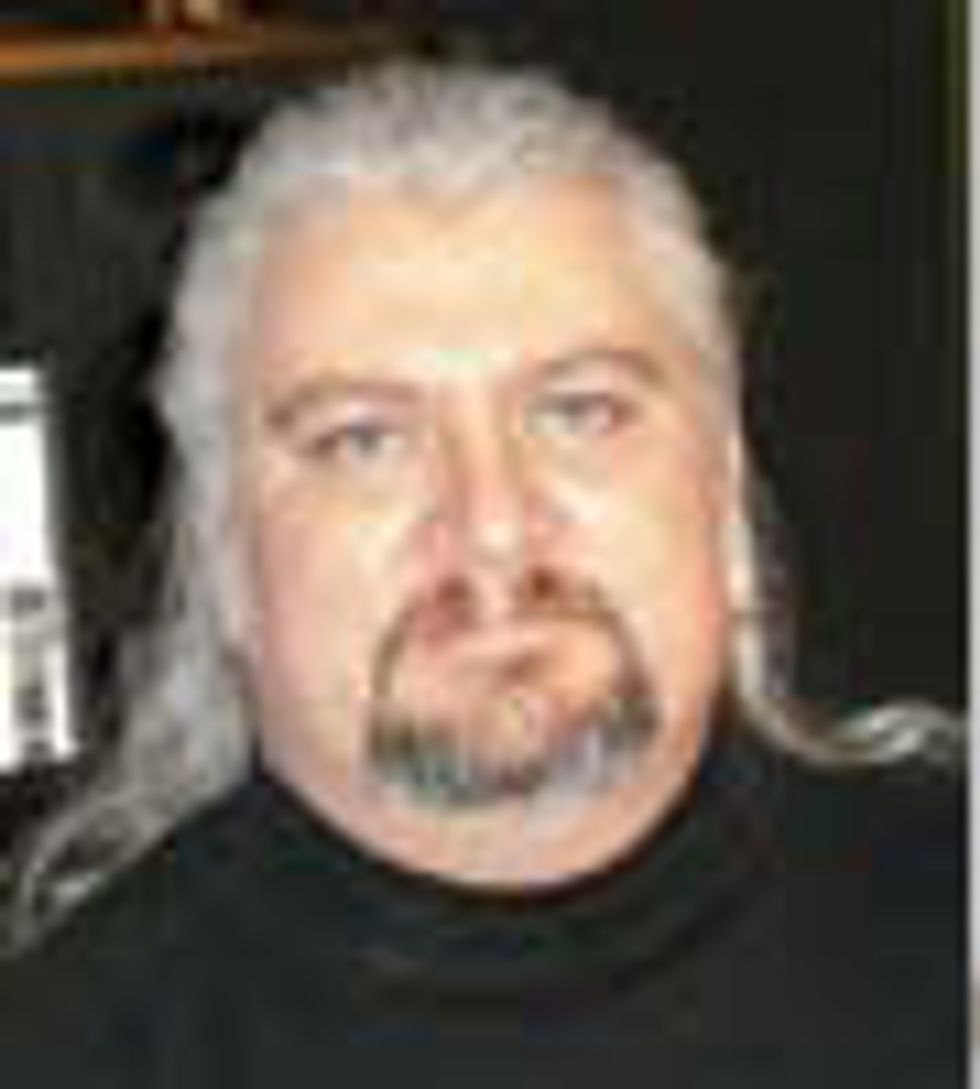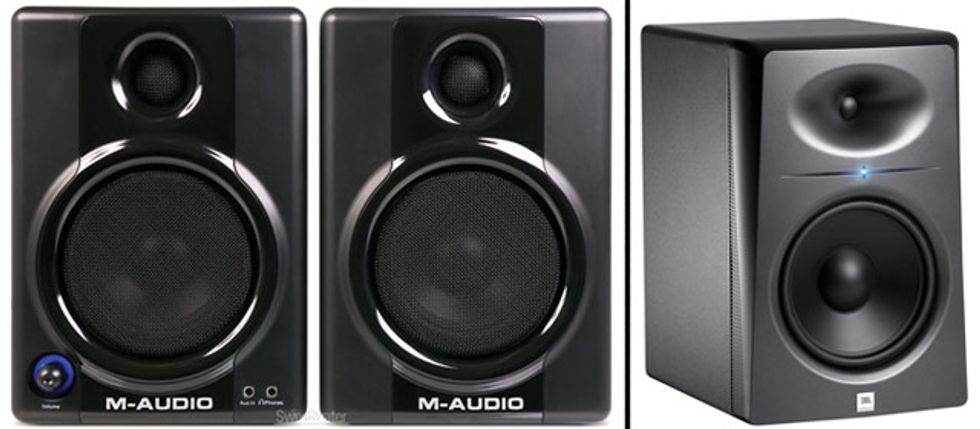LEFT: Studio monitors are not the place to
skimp in your studio. Fortunately, even
a modestly priced set, such as the MAudio
AV 40 ($149 street) can produce
detailed, wide-ranging sounds.
RIGHT: Larger monitors,
such as
a set of JBL
LSR2328Ps
($700 street)
can produce
more bottom
end and lower-frequency
extension.
For the past few installments of Guitar Tracks, we’ve been looking at the front-end (aka capture) portion of our recording rigs—microphones and microphone preamps. Now we’re going to shift our attention to the back end and talk about monitors. In my opinion, monitors are the most important item in your studio. Many musicians spend tons of time obsessing over microphones, mic preamps, and other gear, but then purchase whatever monitors present themselves without a second thought. Big mistake! Mics, preamps, and other gear are super important, but virtually everything you do in your studio—tracking, editing, processing, mixing, and mastering—is determined by the sound you hear out of your monitors. So your monitors simply must be accurate, meaning they must reproduce audio signals without adding coloration to the sound.
What happens if your monitors aren’t accurate? Your mixes and tracks won’t be “transportable.” In other words, your tracks may sound fine through your monitors, but when you go to play them back on your MP3 player, in your car, or on a friend’s stereo system, they won’t sound the same. If your monitors boost the bass, your tracks will sound weak in the low end on other systems. Likewise, if your monitors are heavy in the midrange, your tracks’ mids will sound scooped when played elsewhere. If the monitors are dark sounding or don’t have enough highs, you’ll tend to compensate by cranking the highs on your tracks, which will make them sound bright and harsh when heard elsewhere.
Passive vs. Active. There are two main categories of studio monitors: passive and active. Passive monitors require an external power amp, because they have no amplification built in. On the other hand, active monitors have electronics—including amplification and perhaps even processing such as equalization and a crossover—built in. The crossover splits the signal into separate high, low, and, sometimes, midrange frequencies. Each of these frequency bands is then routed to its own amplifier and speaker inside the monitor, creating a cleaner result than running everything through a single amp and speaker. A 2-way monitor splits the signal into two bands and has two speakers (a woofer or low-frequency driver, and a tweeter or a high-frequency driver). A 3-way monitor splits the signal into three bands and has three drivers—one for lows, one for mids, and one for highs.
It might seem as if a monitor with more drivers would be cleaner and better, but there is definitely a point of diminishing returns—because each of those splits increases the complexity of the speaker design. There can be problems at crossover points and in getting the multiple drivers to work well together—especially at close listening distances. For this reason, we rarely see studio monitors with more than three drivers. In fact, many monitors on the market are 2-way designs.
Near or Far? Another way to categorize studio monitors is by their intended use, or more specifically, the distances from which they are designed to be heard. Far-field monitors are intended for listening from a distance of 10 feet or more. They’re typically quite large, with a lot of power. In commercial studios, these are the big monitors mounted in the front wall. Few of us have enough space in our home or project studios to be able to use far-field monitors.
Mid-field monitors are intended to be listened to from six to 10 feet away. Midfields are usually pretty good-sized monitors, often with a 3-way design, and they usually offer plenty of power. If your studio has a large control room or space, you may be able to use mid-fields to get a wider frequency response with much better low end than smaller monitors.
Near-field monitors are the most common type found in home and project studios. Also known as close-field monitors, they’re designed to be heard from just a few feet away—usually three to six feet. Their advantages for home- and project-studio use include compact dimensions and volume levels that are more convenient for the environments most of us work in these days. Another big advantage of near-fields is that their close proximity reduces the room’s acoustic influence on the sound you’re hearing—which is an especially good thing if the room isn’t well-treated acoustically.
Big vs. Small. Do you need massive monitors to get good low-frequency response? Typically, larger monitors with bigger speakers are better able to reproduce very low frequencies. The other aspect that’s important here is power. There’s a reason why bassists generally use higher-powered amps to compete with guitar amps: Lower frequencies simply require more power to emit a given volume from a speaker than midrange and treble frequencies do.
That said, modern technology allows even smaller monitors to produce a surprising amount of bass. One approach that monitor manufacturers use to enhance low-frequency response is designing a port in the cabinet. A port is a specifically sized opening in the monitor housing that serves to redirect the sound waves from the back of the speakers out to the listener’s ears. If the port is designed well, the sound waves from the back will reinforce those from the front, particularly in the low frequencies. This allows a smaller cabinet to produce bass response that is similar to that of a much larger cabinet.
That’s all for this month, but we’ve got more to cover regarding monitors and monitoring. So be sure to come back next month!
 Mitch Gallagher is
the former editor in chief of
EQ magazine. He’s written
more than 1000 articles
and six books on recording
and music technology, and
has released an instructional
DVD on mastering. His upcoming book is
entitled Guitar Tone: Pursuing the Ultimate
Electric Guitar Sound. To learn more, visit
mitchgallagher.com.
Mitch Gallagher is
the former editor in chief of
EQ magazine. He’s written
more than 1000 articles
and six books on recording
and music technology, and
has released an instructional
DVD on mastering. His upcoming book is
entitled Guitar Tone: Pursuing the Ultimate
Electric Guitar Sound. To learn more, visit
mitchgallagher.com.







![Rig Rundown: Russian Circles’ Mike Sullivan [2025]](https://www.premierguitar.com/media-library/youtube.jpg?id=62303631&width=1245&height=700&quality=70&coordinates=0%2C0%2C0%2C0)


























